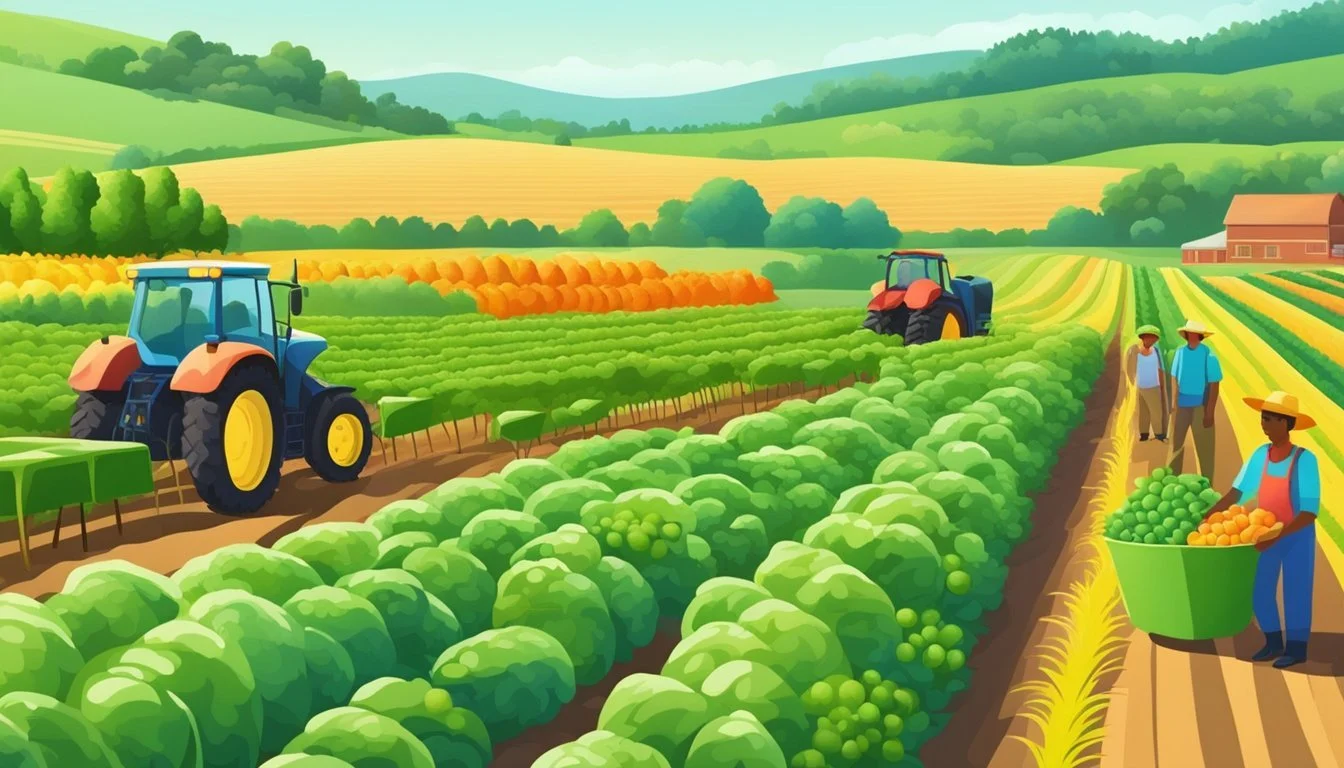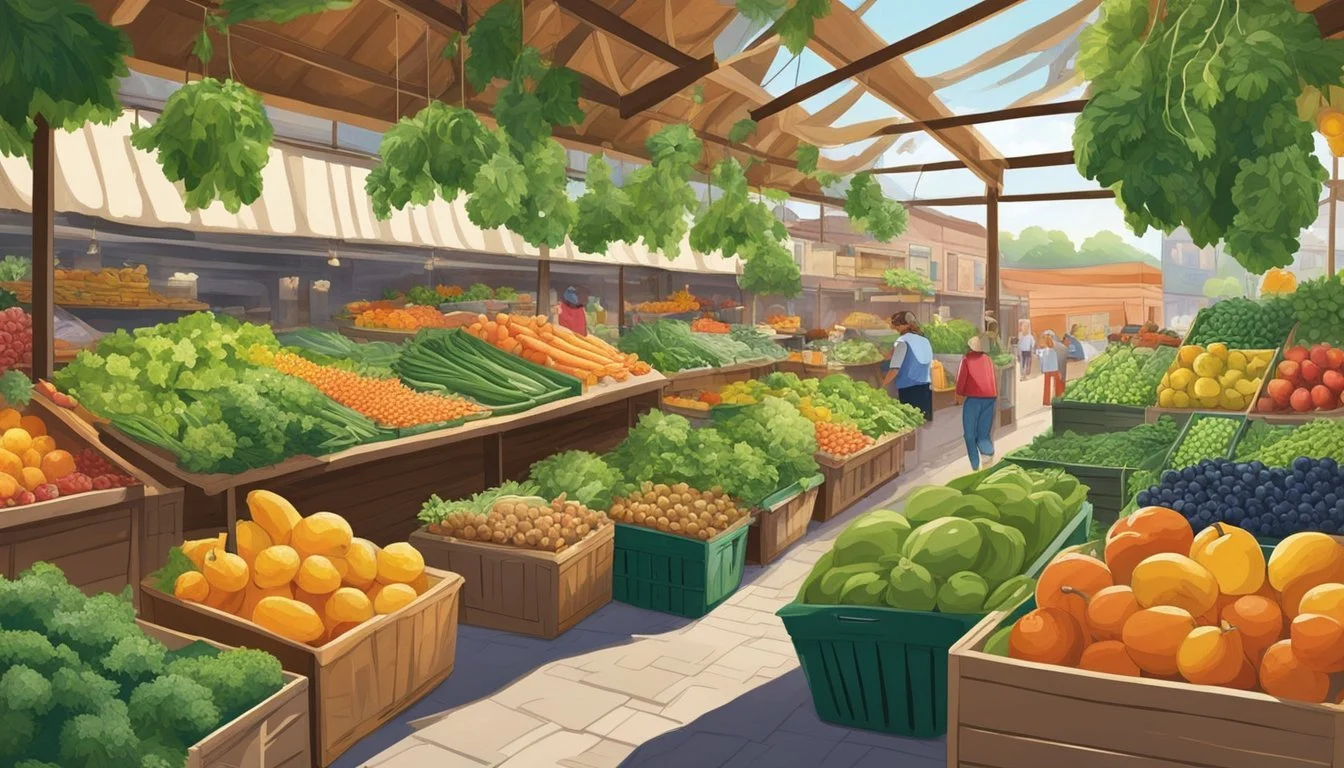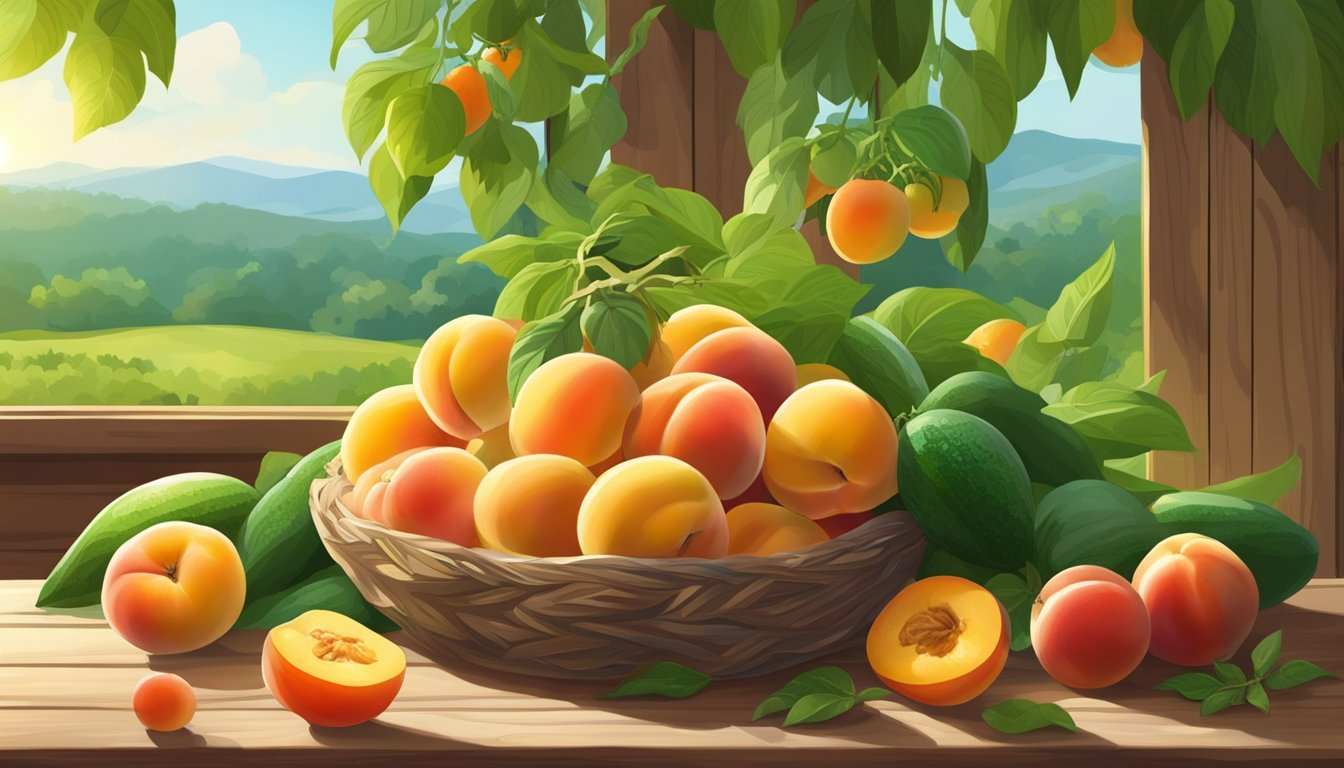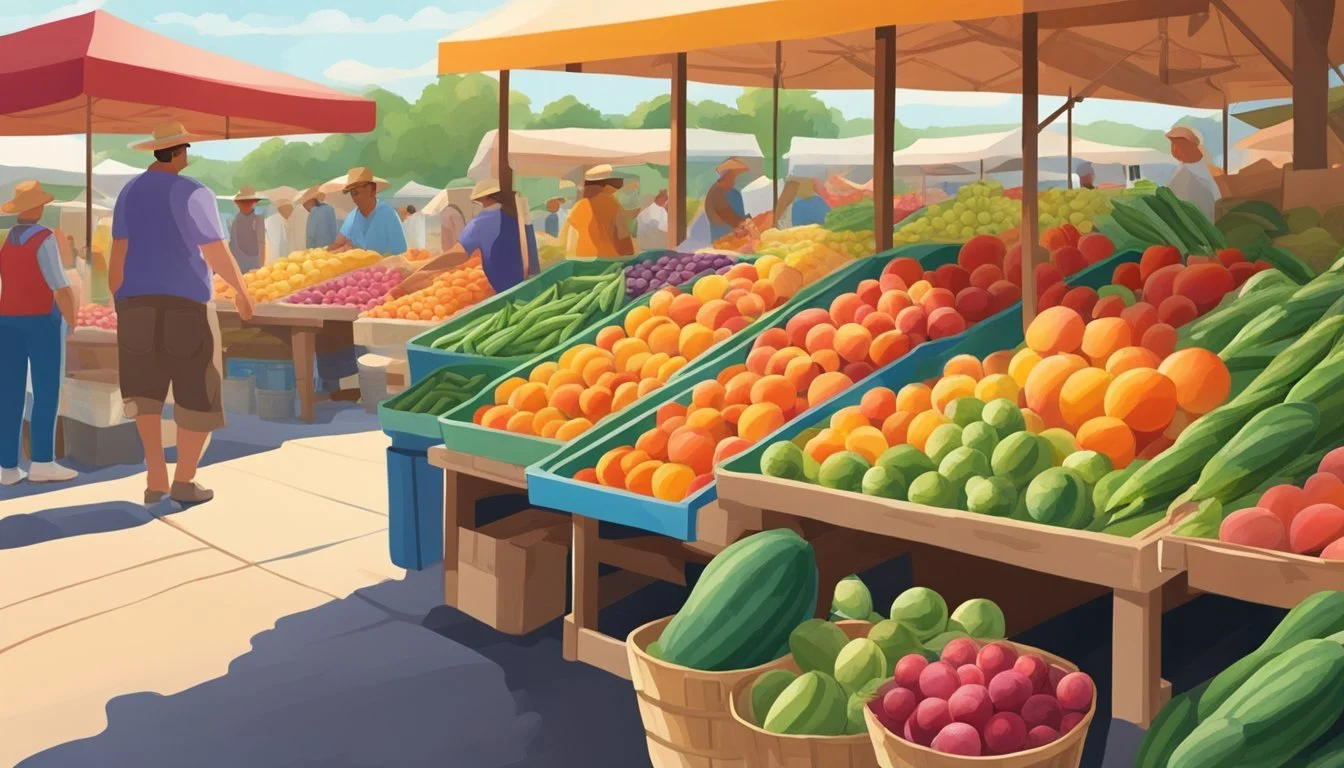Oklahoma Seasonal Fruit & Vegetables in August
Your Fresh Produce Guide
This Article is Part of our Oklahoma Seasonal Fruit & Veg Calendar
August in Oklahoma brings a bounty of fresh fruits and vegetables, as local farms and gardens reach the height of productivity. The summer heat ripens an assortment of produce, making it an excellent time for residents and visitors to explore the flavors of the region. Markets and roadside stands brim with the vibrant colors and enticing aromas of the season's harvest.
During this period, Oklahomans enjoy a variety of fruits including plump, juicy blackberries (how long do blackberries last?)that are perfect for homemade jams, cobblers, and fresh eating. Vegetables also thrive in the August warmth, with a selection ranging from crisp snap beans to earthy beets and robust broccoli. The state's agricultural calendar is centered around maximizing the yield and quality of these seasonal offerings, providing an ample window to indulge in the freshest produce.
Embracing the peak season for these crops not only supports the local economy but also ensures a culinary experience that features the highest nutritional value and taste. Oklahoma's August harvest connects consumers to the land and the cycle of growth, celebrating the abundance that comes from careful cultivation and harmonious agriculture practices.
Understanding Oklahoma's Growing Seasons
Oklahoma's diverse climate and soil conditions contribute to a versatile and robust agricultural sector. Knowing the state's growing seasons helps consumers and farmers plan for the harvest and availability of fresh produce.
Climatic Influences on Agriculture
Oklahoma's climate varies significantly from one region to another, impacting the growing seasons throughout the state. The state experiences hot summers and mild to cold winters. Spring and fall serve as transitional periods with spring often bringing severe weather that can affect planting and early crop growth. The state is divided into several climate zones, ranging from humid subtropical in the east to semi-arid in the west, influencing which crops thrive and when.
In late summer, especially in August, Oklahoma's typically hot and dry conditions prevail, which can both promote and challenge crop production. Farmers often rely on irrigation during this time to maintain crop health.
Seasonal Harvest Calendar
Accurate information about the harvest times for fruits and vegetables is essential for consumers desiring to buy fresh, local produce. Below is a table outlining which fruits and vegetables are typically harvested in late summer, particularly in August, in Oklahoma.
Late Summer Harvest Fruits Vegetables August Apples, Peaches, Plums Okra, Peppers, Tomatoes (What wine goes well with tomatoes?), Sweet Corn, Eggplant (What wine goes well with eggplant?)
The actual dates of availability may vary depending on specific regional weather conditions and farm practices. It is advised for consumers to contact local farms to confirm produce availability. During this time, fall crops such as pumpkins are beginning to mature but are not yet ready for harvest. The transition from the summer to fall season is a busy time for Oklahoma farmers as they prepare to harvest the late summer crops and plant for the fall season.
Seasonal Vegetables in August
August in Oklahoma brings a diverse range of fresh vegetables that are at their peak. With the warm weather, consumers can find a variety of vibrant and nutrient-rich produce to add to their meals.
Leafy Greens
During August, leafy greens like chard, kale, and spinach are in abundance. These greens can be identified by their dark, richly colored leaves, a sign of their high nutrient content.
Chard: Look for bright, firm leaves.
Kale: Choose leaves that are deep green without yellowing.
Spinach: Opt for spinach with tender, yet crisp leaves.
Root Vegetables
Root vegetables, such as turnips and radishes, are also plentiful. These vegetables thrive in the summer soil, providing crisp textures and earthy flavors.
Turnips: They should be firm and heavy for their size.
Radishes: Select brightly colored radishes with smooth skin.
Nightshades
Nightshades like peppers, tomatoes, and eggplant (What wine goes well with eggplant?) are at their best in August. These vegetables are known for their rich colors and deep flavors.
Peppers: Choose firm and glossy peppers with taut skin.
Tomatoes: Look for vividly colored and fragrant tomatoes.
Eggplant: Select eggplants that are heavy for their size, with smooth, shiny skin.
Gourds and Squash
Finally, gourds and squash, such as cucumbers, zucchini, okra, and summer squash, are essential parts of the August harvest.
Cucumbers: They should be firm, dark green, and relatively thin.
Zucchini: Select small to medium-sized zucchini for the best flavor and texture.
Okra: Look for bright green, tender, but firm pods.
Summer Squash: Choose smaller, firmer squash for a sweeter taste.
Seasonal Fruits in August
In August, Oklahoma's produce selection is rich with a variety of fruits reaching their peak ripeness. This month is ideal for berry lovers and stone fruit enthusiasts, as well as those who savor the juicy refreshment provided by melons.
Berries and Small Fruits
During the month of August, berries abound in Oklahoma. This is the time when consumers can find the freshest and most flavorful blackberries and blueberries. They can also enjoy ripe raspberries, though the season for these may be tailing off. It's important to select berries that are plump and rich in color, without any signs of bruising or soft spots.
Blackberries: Look for deep purple, almost black fruits.
Blueberries: Choose berries that are uniformly blue, with no tinges of red.
Stone Fruits
Stone fruits are a true highlight of August. Oklahoma sees a variety of these fruits hitting the markets and stands, with peaches leading the seasonal surge. Shoppers should look for fruits that yield slightly to pressure and emit a sweet fragrance.
Peaches: The flesh should be firm, but not hard, and the skin should show a warm, creamy background color.
Plums: These should be plump and well-colored.
Nectarines: Similar to peaches in texture, go for smooth, unblemished skin.
Apricots: They should be slightly soft, with a rich, orange color indicating ripeness.
Melons
Melons are synonymous with summer, and in August, they are in abundance in Oklahoma. Watermelon and cantaloupe (how long does cantaloupe last?) are at their peak, offering a hydrating and sweet experience. These melons should feel heavy for their size, a hint at their juiciness, and should sound hollow when tapped.
Watermelon: A creamy yellow spot where it rested on the ground is a good indicator of ripeness.
Cantaloupe: Netted skin and a subtle fragrance suggest it is ready to eat.
Herbs and Other Produce
August in Oklahoma presents a bounty of herbs and other garden produce that thrive in the summer warmth. These items bring flavor, nutrition, and variety to the table.
Aromatic Herbs
Basil is plentiful during the month of August. The herb’s leaves are vibrant green, offering a warm, sweet, and slightly peppery flavor that is essential in many culinary dishes. Arugula, another herb commonly found in this month, provides a peppery, slightly bitter taste, perfect for salads and garnishes.
Basil: Sweet, peppery flavor; vibrant green leaves
Arugula: Peppery, slightly bitter taste; adds a kick to salads
Miscellaneous Garden Produce
Other produce such as sprouts, parsnips, onions, garlic, leeks, celery, and kohlrabi are also harvested in August. Each brings its own set of characteristics and uses:
Sprouts: Crunchy and nutritious, ideal for salads and sandwiches.
Parsnips: Sweet and earthy, often roasted to accentuate their flavor.
Onions and Garlic: Pungent and flavorful, fundamental in savory recipes.
Leeks: Mild onion-like flavor, used in soups and sautéed dishes. (What Wine Pairs Best with Sautéed Dishes)
Celery: Crisp texture and mild taste, commonly used in salads and as flavoring in soups.
Kohlrabi: Slightly sweet, turnip-like flavor, can be eaten raw or cooked.
The produce harvested during this time is known for its ability to bring depth and complexity to dishes. Gardeners and farmers in Oklahoma take pride in the variety and quality of these ingredients.
Gardening Tips for August Produce
In August, Oklahoma gardeners should focus on managing pests and preventing diseases to ensure the health and productivity of their produce. Accurate identification of issues and timely intervention is crucial for the success of the garden.
Pest Management
For pest control in Oklahoma gardens during August, gardeners should remain vigilant and take a proactive approach. Regular monitoring is essential to catch pests before they cause significant damage. Gardeners might use an app or manual tracking to keep tabs on pest activity.
Common Pests:
Aphids
Spider mites
Squash bugs
To manage these pests, gardeners can employ a variety of methods:
Mechanical Control: Hand-picking larger pests and using water sprays can physically remove pests without the use of chemicals.
Biological Control: Introducing beneficial insects that prey on these pests, such as ladybugs for aphids, can help maintain a natural balance in the garden.
Chemical Control: When necessary, use appropriate insecticides, preferably organic, ensuring they are suitable for the specific pests and plants.
Disease Prevention
Disease prevention in gardens requires attention to cleanliness, proper watering practices, and crop selection:
Watering Practices: Water plants in the morning to allow foliage to dry throughout the day, reducing the likelihood of fungal diseases.
Crop Rotation and Diversity: Rotate crops yearly and plant a diverse array of produce to decrease disease incidence.
Hygiene: Regularly clean tools and remove plant debris to minimize disease spread.
Key Strategies:
Fungicide Application: As a preventative measure, apply fungicides labeled for garden use, according to the manufacturer's recommendations.
Resistant Varieties: Choose plant varieties known for disease resistance, especially when planting tomatoes, peppers, and squash, which are prone to common diseases.
By implementing these targeted strategies for pest management and disease prevention, gardeners can protect their August produce and maximize the yield of their gardens.
Health Benefits of August Produce
August brings a bounty of seasonal fruits and vegetables to Oklahoma, each packed with essential vitamins and nutrients. These seasonal picks not only contribute to a colorful plate but also offer health benefits that align with dietary recommendations.
Vitamins and Nutrients
Fruits and vegetables harvested in August are often rich in vitamin C and antioxidants, which are crucial for maintaining a healthy immune system and preventing cellular damage. For example:
Apples: Contain vitamin C and a variety of antioxidants.
Plums: Known for their content of vitamin C and unique antioxidants.
Tomatoes: Provide vitamin C, antioxidants, and lycopene, which has been linked to reducing the risk of heart disease and cancer.
Food Item Vitamin C Content Antioxidants Present Apples Moderate Quercetin, Catechin Plums High Anthocyanins Tomatoes High Lycopene, Vitamin E
Dietary Considerations
Seasonal produce contains dietary fiber, which supports digestive health, and iron, an essential mineral for blood production. The consumption of these fruits and vegetables can help meet the Dietary Guidelines for Americans' recommendation for daily fruit and vegetable intake. They encourage variety, which is easily found in an August harvest, helping individuals to include different nutrients and reduce the risk of chronic diseases.
Iron: Crucial for the transport of oxygen in the blood.
Dietary Fiber: Aids with digestion and provides a feeling of fullness, which can be beneficial for weight management.
Eating seasonal produce, such as those available in August, not only ensures the intake of diverse nutrients but also supports local agriculture and can be more sustainable.
Recipes and Preparation Ideas
Oklahoma's August harvest provides an abundance of fruits and vegetables that are perfect for refreshing summer salads and sweet, indulgent desserts. The following ideas harness the full potential of peak-season produce for delightful dishes.
Summer Salads and Desserts
Salads: They can easily become a centerpiece with Oklahoma’s ripe produce. One can create a vibrant Peach and Tomato Salad by slicing fresh peaches and heirloom tomatoes, adding a sprinkle of basil, and drizzling with a balsamic reduction. To add a protein punch, toss in some mozzarella or goat cheese.
Berries: A traditional Berry Pie highlights the tart and sweet flavors of blackberries, strawberries, or blueberries. One can incorporate a lattice crust for an added visual appeal and a scoop of vanilla ice cream for the perfect balance.
Stone Fruit Desserts: Desserts like Grilled Peach Sundaes are a real treat. Simply grill peach halves until caramelized and top with a scoop of vanilla bean ice cream; drizzle with honey or sprinkle with crushed pecans (how long do pecans last?) to enhance the dish’s natural sweetness.
Preserving the Harvest
Pickling and Canning: August's bounty can be preserved through pickling and canning. Create a variety of pickles or relishes using cucumbers, peppers, and okra. For a sweet side or dessert topping, one can can peaches or make a berry compote.
Sauces: Homemade tomato sauces from vine-ripened tomatoes can be canned and saved for future meals. Incorporating herbs like basil, thyme, or oregano, along with garlic, will deepen the flavor, ideal for pasta dishes or as a base for eggplant parmesan (What wine goes well with eggplant parmesan?).
Eggplant: Speaking of which, one should take advantage of the prime eggplant season by preparing dishes like Baba Ganoush, an eggplant dip perfect for snacking, or Eggplant Parmesan, a comforting, cheese-laden dish that captures the essence of summer produce in a baked, savory masterpiece.
Where to Find Seasonal Produce
In August, shoppers looking for the freshest in-season produce in Oklahoma have a variety of options. They can visit local farmers' markets for directly sourced fruits and vegetables or navigate the grocery stores' produce sections with an eye for local and in-season items.
Local Farmer's Markets
Farmers' markets are prime locations for fresh, locally grown produce. Consumers can find a diverse range of fruits and vegetables that are in peak season. Oklahoma's farmers' markets typically offer:
Fruits: Apples, peaches, melons
Vegetables: Okra, tomatoes, squash, cucumbers, peppers, onions
To ensure the best selection, visitors are recommended to arrive early. Prices and availability may vary, but most markets allow buyers to speak directly with growers.
Grocery Shopping Tips
When shopping at a grocer, quality and freshness can be found in the produce sections. For the best experience:
Look for signs that highlight local or in-season produce, as these are often fresher and support local agriculture.
Check for firmness, vibrant color, and avoid produce with bruises or blemishes.
Be aware that some items might be available from storage or greenhouses outside their typical season.
For those interested in in-season fruits and vegetables, grocery stores in Oklahoma strive to stock fresh local produce, but availability might depend on factors such as weather and specific store policies.
Planning for Fall and Winter
As August unfolds, gardeners in Oklahoma should pivot their focus towards crops that thrive in the cooler temperatures of fall and winter.
Upcoming Seasonal Shifts
Gardeners need to consider the shorter days and cooler nights that are characteristic of the upcoming months. Certain crops, particularly pumpkins and potatoes, are well-suited for these conditions. For the fall, one can plant pumpkins in early August to ensure a harvest before the first frost. They should prepare the soil with plenty of organic matter and consider the space pumpkins require to sprawl.
Potatoes planted in the latter half of August can yield a fruitful harvest in late fall or early winter. Select a sunny spot with well-draining soil to encourage robust growth. Additionally, it is crucial to monitor moisture levels since both pumpkins and potatoes require consistent watering to flourish, especially during the dry spells commonly experienced in late summer.
Supporting Local Agriculture
In Oklahoma, August is a significant period for local agriculture, where residents have a chance to contribute directly to the sustainability and success of their regional food system through various means.
Community Supported Agriculture (CSA)
Community Supported Agriculture, commonly known as CSA, is a model that connects the people of Oklahoma with their local farmers. Subscribers to a CSA purchase "shares" from local farms, typically receiving a weekly or bi-monthly assortment of seasonal produce. In Oklahoma, CSAs might include:
Vegetables: Tomatoes, zucchini, peppers, and other vegetables that are easy to grow in the state's summer climate.
Fruits: Options such as watermelon and peaches, which reach peak ripeness in August.
Farm to Table Initiatives
Oklahoma’s Farm to Table initiatives are designed to reduce the distance food travels from production to consumption. These initiatives not only ensure that households receive fresh, nutrient-dense produce but also strengthen the local economy. Key aspects include:
Purchases: Food institutions buy fresh produce directly from local growers.
Accessibility: These programs aim to provide for Oklahomans who struggle with food insecurity.
By supporting CSA programs and Farm to Table initiatives, residents foster a resilient local agricultural sector.








